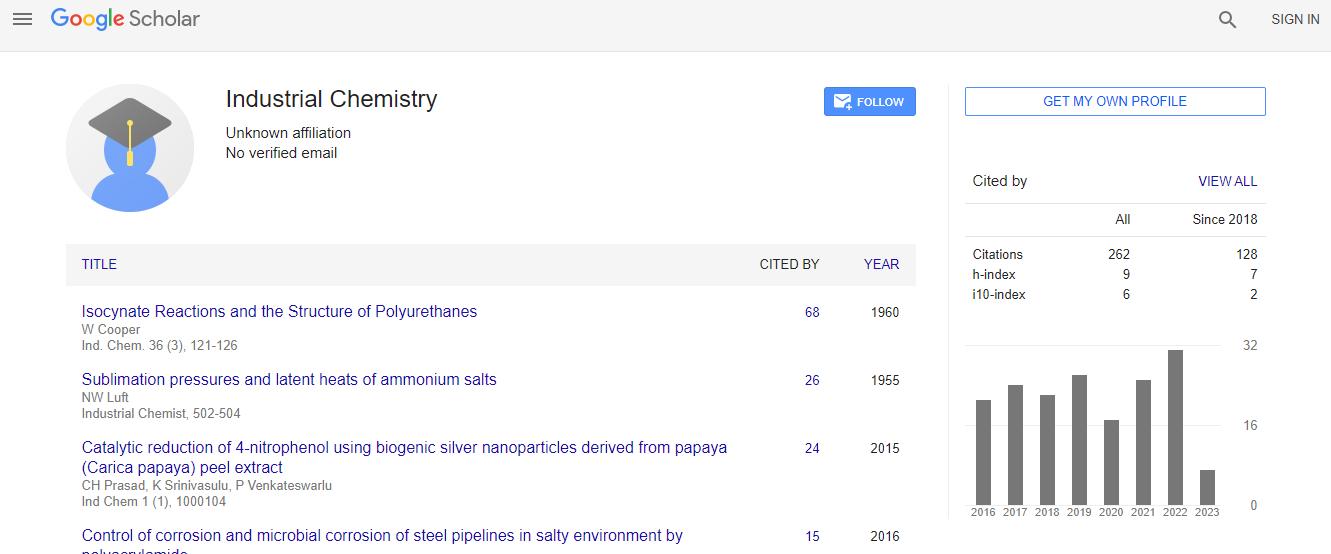Our Group organises 3000+ Global Conferenceseries Events every year across USA, Europe & Asia with support from 1000 more scientific Societies and Publishes 700+ Open Access Journals which contains over 50000 eminent personalities, reputed scientists as editorial board members.
Open Access Journals gaining more Readers and Citations
700 Journals and 15,000,000 Readers Each Journal is getting 25,000+ Readers
Google Scholar citation report
Citations : 262
Industrial Chemistry received 262 citations as per Google Scholar report
Indexed In
- Index Copernicus
- Google Scholar
- RefSeek
- Directory of Research Journal Indexing (DRJI)
- Hamdard University
- EBSCO A-Z
- OCLC- WorldCat
- Scholarsteer
- Geneva Foundation for Medical Education and Research
- Euro Pub
Useful Links
Recommended Journals
Related Subjects
Share This Page
Inactivation and degradation of antibiotic-resistant bacteria and its gene by Cu (II)/H2O2 system
2nd World Conference on Industrial Chemistry and Water Treatment
Byung-Taek Oh, Young-Seok Seo, Seol Ah Kim, Jung-Muk Lim, Jeong Yeol Lee, Aerin Kim, Gyunggeun Lee, Sewon Lee and Min Cho
Chonbuk National University, South Korea
Posters & Accepted Abstracts: Ind Chem
Abstract
This study deals with the degradation and/or removal of antibiotic resistant bacteria (ARB) and antibiotic resistant gene (ARG) using Cu(II)/H2O2. The removal of ARB using Cu(II) was achieved, however, the inactivation capability was considerably improved when supplement with H2O2. The improved ARB inactivation was confirm by: (1) Addition of copper chelating agents, EDTA (for Cu(II)) and DMP (for Cu(I)) to block Cu(II)/Cu(I) redox cycle, (2) Addition of radical scavenger t-BuOH proving that ARB is mainly inactivated by Cu(III), and (3) Addition of H2O2 to produce Cu(I) and Cu(III). To investigate the cell destruction, PI staining was applied to check cell membrane integrity, and cell-permeability test to identify intra- and extra-cellular oxidative damage. In case of ARG inactivation, the efficiency was up to 5.5% when Cu(II) was treated alone, then it was improved up to 85% within 20 min when supplement with H2O2 in the reaction. Therefore, it is concluding that Cu (II)/H2O2 system is not only potential for inactivation of ARB but also inactivation of ARG under neutral pH condition.Biography
Byung-Taek Oh is an Environmental Scientist, Author and Educator, who developed a new strategy in toxic pollutant remediation field. His expertise and contextual evaluation model based on responsive constructivists creates a new pathway for improving environmental pollution removal. He has framed a network in research to create a model to remediate microbes and toxic pollutant from environment has added a feather to his cap. He has built this model after years of experience in research, evaluation, teaching and administration both in laboratory and education institutions. The research foundation is based on his American carrier with network development and his excellence in environmental research by measurement, description and judgment. He has awarded with excellence in several aspects of research by his university and in several research occasions.
Email: btoh@jbnu.ac.kr

 Spanish
Spanish  Chinese
Chinese  Russian
Russian  German
German  French
French  Japanese
Japanese  Portuguese
Portuguese  Hindi
Hindi 